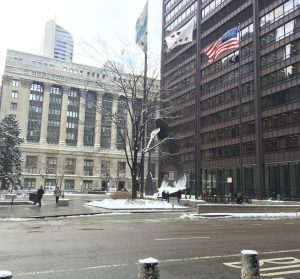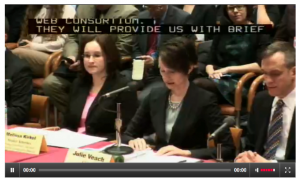An atrium outside Family Focus Lawndale’s Homan Square office is decorated with large, brightly colored pedestals adorned by children’s artwork. Young people from the Lawndale neighborhood made and decorated these pedestals at a summer camp this past June and July. Visitors to the office sit on the pedestals and rest while waiting for services.

This functional, colorful artwork was not just a fun camp service project, but also an opportunity for art education and therapy through art at a time very many CPS students go without exposure to art in a structured classroom setting.
The lack of formalized art instruction in CPS classrooms has increasingly become an issue, especially since CPS and the Chicago Teachers Union recently agreed to lengthen the school day.
Attention has now turned to what the structure of a longer day might look like. For some parents, educators and social service providers, it’s the perfect opportunity to stress the importance of art and not shortchange the students who need it most.
“They’re getting cheated on the quality of their day,” said CPS parent Wendy Katten, a member of the parent organization Raise Your Hand. “Without art or music, it’s education on the cheap.”
CPS provides funding for either a half-time music teacher or a half-time art teacher if the school’s population is at or under 751 students, Raise Your Hand members say.
That means that around 75 percent of CPS schools only receive funding for a half-time art or music teacher, according to data available from CPS’s Office of Performance.
So most CPS schools have to find outside funding or bring in independent contractors in order to provide art education to students.
For art therapist Larry Crost, an independent contractor who works with CPS and the Chicago Park District, art education is not a luxury for more well off times and places, but a tool for empowering youth and building community in struggling neighborhoods.
Crost has partnered with social service organizations such as Family Focus Lawndale in order provide a kind of art-intervention to at-risk kids in Chicago’s schools and neighborhoods.
“Expressive therapies, such as art therapy reach into the mind ways talk therapy can’t,” said Justen Boyd, a social worker at Family Focus Lawndale.
Crost and Boyd were the facilitators who provided the space, materials, and guidance for the summer camp students who used art to address Homan Square’s need for seating with their cheerful pedestals.
Crost points to the children’s community-serving art as “creative-problem solving at its best.”
“It teaches creativity in a way you can’t learn from a book,” said Boyd.
Creativity is essential for the future success of students, said Boyd.
“We’re trying to prepare kids for jobs we don’t even know about yet out there.”
DeShawn Gaston, 15, of Lawndale, was one of the students who helped make the colorful pedestals. For Gaston, a student at Westinghouse High School, art is more than a class. It’s a way of life that he said has helped him be happier, get into a good high school, and realize his dream of becoming an architect.
“Life would be, like, really bleak without art,” said Gaston. “The future depends on art right now—schools without art don’t understand how things are and don’t express their feelings.”
Boyd and Crost agree that art helps kids develop self confidence and independence, makes them better communicators and fosters skill-sets that reach across subjects to help students perform better in standard classes like math and reading.
Gaston smiled when asked about the way art has impacted his life.
“It makes me want to try more stuff, to make the world see,” he said.
“Art doesn’t take a lot. Just let out your stuff. You’ve just got to try.”












Be First to Comment